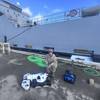HTS Propulsion Thrusters Project Gets $3.1M Boost
American Superconductor Corporation received a third contract valued at $3.1 million from the
U.S. Navy's Office of Naval Research (ONR) to continue the design and development of high temperature superconducting (HTS) motors and related subsystems for electric ship propulsion. The company expects to complete this contract within the next nine months, and anticipates receiving additional contracts from the Navy leading to initial sea trials of an HTS propulsion system by the end of 2003.
The latest contract calls for the design and fabrication of components for pod-contained, HTS propulsion motors. Propulsion thrusters comprise hydrodynamically shaped pods that contain an electric motor to drive a propeller. Commercial propulsion thrusters utilize conventional electric
motors. Attached to the external hull of a ship, they look very much like an aircraft engine attached to the wing of an airplane and serve a similar purpose.
American Superconductor's proprietary, ultra-compact, more efficient HTS motors are expected to be one-fifth the size and one-third the weight of conventional electric motors of the same power rating. HTS thrusters, because of their smaller size and higher efficiency, are expected to provide significant increases in maneuverability, fuel efficiency, and cargo and passenger space, among other advantages.
"Electric drive systems for commercial and Navy ships is the 'killer app' for HTS motors," said Greg Yurek, American Superconductor's chief executive officer. "The dramatic reductions in size, weight and manufacturing costs created by HTS technology are leading to radically new ship designs, which provide tremendous tactical and operational advantages to the Navy and
pathways to increased profitability for commercial ships."
Nearly all cruise ships and many cargo ships built today use electric motors to drive propellers. Approximately 70 percent of these ships utilize propulsion thrusters. The remaining 30 percent have electric motors located inside the ship's hull. In January 2000 the U.S. Navy announced that it targets electric drives for all future propulsion systems in its warships.
Both in-hull and thruster designs are under consideration for Navy applications.
According to some industry sources, the current annual global market for electric motors and generators utilized for electric propulsion in commercial cruise and cargo ships is approximately $400 million. The market for ship propulsion motors and generators is expected to grow rapidly to $2 billion to $4 billion per year by 2010 because electric drives are becoming the propulsion system of choice for both commercial and Navy ships.









